
Index |
Next |
Prev |
The Death Of Franz Schubert
I Made A Watch
The Death Of Franz Schubert
1:30pm, Friday, March 25, 2022
Current mood: calm ![]()
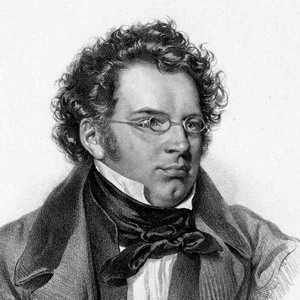

Franz Schubert by Kriehuber 1846 and the Borodin Quartet with Alexander Buzlov performing his Quintet in C.
It was in September 2020 that I first heard Schubert's wonderful String Quintet in C. It was one of the classical pieces that my mother nominated as her favourites when I set about writing a poem on the subject for her birthday that year. I hadn't heard of this famous work but I had to listen to it before I could finish the poem so I found a live version performed by the Borodin Quartet with Alexander Buzlov on YouTube and pressed play.![]()
Schubert's String Quintet in C was written just 2 months before his untimely death in November, 1828 at the age of 31. The first public performance of the piece did not occur until 1850, (22 years later). Schubert submitted it to one of his publishers, Heinrich Albert Probst, before his death but the publisher was not interested in looking at it. After his death his brother Ferdinand sold it to the publisher Diabelli who neglected it for 25 years. It was finally published in 1853. The original manuscript and sketches have been lost.
Many chamber music fans have fallen in love with the work, especially the first two movements. Brahms was inspired by it to write his Piano Quintet. The violinist Joseph Saunders had the main theme of the first movement carved on his tombstone and you can watch the great pianist Arthur Rubinstein on YouTube saying that he loved it more than anything and wanted it played as he was dying. He said it was the entrance to heaven.![]()
Schubert had been ill for some years (probably with syphilis) and 3 months before the end he saw his doctor Ernst Rinna, who most likely would have confirmed Schubert's suspicions that he was ill beyond cure and likely to die soon. It seems likely that Franz wrote this Quintet knowing his end was not far off. Many lovers of the work, including myself, believe that this was his goodbye to the world. Schubert did not say so explicitly but it is hard to believe anything else when you consider how tender and special it is in comparison with his other pieces.
In my opinion the main theme of the 1st movement is the most beautiful theme ever written. It is long, it is complex, (but never for the sake of complexity), it is divinely beautiful and it is harmonious. It uses 3 keys in a single statement of the theme alone. I am not aware of any other theme of note that does that. It uses the two beautiful but rarely used devices of the major 9th and the half diminished 7th to great effect but it uses them sparely. The theme is beautifully balanced and superbly arranged for 2 violins, a viola and 2 cellos. It really is one of the great masterpieces of classical music and it never fails to touch me deeply each time I hear it.![]()
I was hooked by this magical movement from the 1st time that I heard the main theme which begins with 2 cellos in close harmony. It piqued my interest and during the 2nd listening I fell madly in love with it. I couldn't get enough of it. I played it and played it, seeking out all the versions available on YouTube. I started to analyse it, playing snatches on the piano as I was listening. Then I downloaded the score and set about analysing it properly. I had just finished my arrangements of my 44 Songs From The Lord Of The Rings and immediately began working on a piano arrangement of that movement.
It is one thing to do a piano REDUCTION, any music student worth his salt can do that, although it is not easy as one cannot put every note from the Quintet onto the piano and make it playable. Nevertheless it is possible to put most of it on and there are piano reductions available that do just that. I have a version by Ludwig Stark for example which is overly difficult from a pianists point of view and unsatisfactory from a listeners point of view essentially because a string quintet is not a piano!
I was halfway through my piano adaptation before I even glanced at Stark's reduction so my version owes nothing to his. I only looked at it because I was curious to see whether he was taking my approach. He wasn't. I quickly realised that although Schubert's arrangement is sublime for a string quintet it is not suitable for the piano and in order to make it sing on that instrument it was necessary to ditch quite a lot of the surrounding voices and bring in some new parts. Here are some of the reasons I came to this realisation:
Sometimes it is good to play things in octaves as the written parts do, other times not. For example: fast scales in octaves do not always work on the piano in this piece, similarly sensitive melodies. Sometimes two voices in harmony are wonderful, other times not. For example: diminished arpeggios in 6ths may be possible but IMO they detract from the impact of the simple arpeggio proper. Sometimes an accompanying figure may be simply impossible to include in a piano arrangement because the hands can't reach it or fit it in. Sometimes an accompanying figure may simply be inappropriate for the piano. Schubert makes extensive use of suspensions in this work which are very effective on the strings but not so good on a piano. Just because it works in a quintet doesn't mean that it will work on a piano. etc...![]()
You might say at this point that my piano realisation is an "arrangement" rather than an "adaptation" since an adaptation requires more than just altering the supporting parts. An adaptation requires taking liberties with the harmonic basis and melodic line and/or introducing new material and/or deleting existing material. Well, I must confess, I did make some alterations and that is why I am calling my work an adaptation.
Perhaps controversially, I found in trying out chord voicings that some of Schubert's chord choices were questionable. These generally occur when Schubert is so intent on giving each part something good to play that he neglects the harmony of the ensemble. In fact I found some of these to be so sub-optimal that I changed them to another chord entirely. These occur only occasionally. The student of my adaptation can discover where those are for himself. The ordinary listener will not hear anything different but the musical expert certainly will. No doubt numerous Schubert fans will decry my alterations and shout: "Sacrilege!" but I believe that I have improved the harmonic basis, (albeit only slightly), which is to the benefit of the listener. Finally I was forced to changed a very few melody notes and move them just slightly to make things work optimally. There were a few cases where the tune didn't quite get to where I felt it was heading due to otherwise valid supporting lines generating a harmony that prevented this. Again, these instances occur when Schubert insists on a part idea at the expense of the whole. These I nudged so that the tune could reach its destination. I must stress that there are VERY few of these.![]()
I intended to keep the guts of the music that I loved, (the tune, its harmony and the rhythm) and that is what I have done. My adaptation is bar for bar in line with Schubert's score. The melodic line is almost entirely the same. The harmonic basis is mostly the same. The accompaniment is sometimes the same, sometimes similar and sometimes different entirely. Overall I believe that any lover of the work that approaches my version with an open mind will find it a wonderful adaptation for the piano and that includes especially the pianist who plays it.![]()
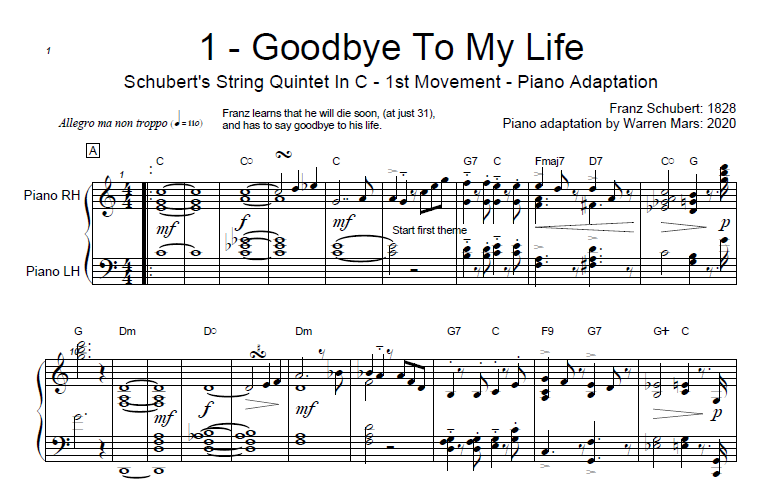
An extract from the first page of my adaptation.
Since this was the last major work before his death and since he was probably thinking about that as he wrote it, I decided to assign each movement of this work to a stage in the process of his death. This is the reason for the title!
1 - Goodbye To My Life (Movement 1 - Allegro ma non troppo)
The beautiful main theme which is played 3 times, (if you follow the repeat), twice starting in Eb and once starting in Ab, (there are also snatches of it in G, A and C), is so sweet and poignant that I could only ascribe it to the sadness of having to lose your own life long before you are ready. If you think it is hard to lose a loved one, imagine how hard it is to lose your own life at just 31 with your world just starting to open up for you. All Franz's hopes and dreams of what he could achieve and experience, all just destroyed due to no fault of his own. It is terribly sad for someone to have to lose so much and one might think that this might have made him bitter, yet he loved those dreams so dearly that he had no time for bitterness in saying goodbye to them, which is what gives the theme its sweetness.![]()
2 - At The Gates Of Death (Movement 2 - Adagio)
Rubinstein called this movement "The Gate Of Heaven". Certainly it has deep pathos and elevated spirituality about it that is matched only rarely by some other religious works such as Fauré's "In Paradisum" or the slow movement of Beethoven's 9th symphony. Many people read ascension into heaven into this incredible movement. It is so sparse yet so moving! There is a storm in it of course, which I take to be Franz' unwillingness to die when he is not ready. Franz loses the fight of course and at last comes to accept his end before his soul moves beyond to "Heaven".![]()
I do not believe in a Christian "Heaven" so I named it "the Gates of Death" rather than "the Gates of Heaven". Religious people can think of it as Heaven if they wish. It amounts to much the same.
3 - Funeral For A Little Mushroom (Movement 3 - Andante sostenuto)
Schubert was nicknamed "Schwammerl" by his friends, meaning "Little Mushroom". It was a sign of endearment from his friends, who stood by him while he was alive and worked to popularise his music after his death. As he was only 1.56 m (5'1") tall with a friendly round face no doubt the nickname is appropriate. Furthermore if it was good enough for his friends it should be good enough for the title of this movement. Referring to him by his nickname provides a sense of the real person that only his friends and family would know. It would be denying his life as a human being if I were to ignore that name.
This little movement contains the outpouring of grief felt by mourners at a funeral for the departure of their loved one, perhaps as they are slowly walking behind the hearse.![]()
Note that this little trio as written by Schubert is sandwiched in the middle of a repeated scherzo. This scherzo is inappropriate for a funeral so I removed the first instance of it.
4 - Celebrating The Birth Of A New God (Movement 3 - Presto)
This scherzo is a cheerful rumbustious dance, which is appropriate for a session of carousing to celebrate the achievement of another great composer from Vienna. It could be a wake or simply a celebration of the achievements of the great man at any time after the funeral was complete.
It may also be the scene of carousing in heaven as Schubert takes his place amongst the pantheon of the gods of music such as Beethoven, Bach and Mozart. To have found himself in such elevated company no doubt would have made young Franz very happy indeed and more than made up for the shock of being torn away from his life so early.![]()
5 - A Composer's Legacy (Movement 4 - Allegretto)
After the funeral has been held and mourning done it is time to consider what that person's legacy was. In Franz Schubert's case it was very considerable. Once famous composers like Brahms, Schumann, Mendelssohn and Sullivan got hold of his stuff they publicized it and elevated his status all over Europe. Now he is considered one of the greats and his music is performed all over the world.
His output was astonishing. By the time of his death at 31 he written over 600 art songs, 9 symphonies, various other orchestral works, 6 masses, numerous short religious works, numerous stage works including 6 operas, numerous choral works, 15 string quartets and numerous other chamber music, various piano duets, dances, marches and overtures and 23 piano sonatas. For sheer quantity his output is comparable to any of the other greats, his short life notwithstanding.![]()

I took this photo of Schubert's grave in the Vienna cemetery when I visited it in 2013.
In order to realise my vision for this piano adaptation and to properly do justice to this masterwork I had to really dig deep musically and match wits with Franz Schubert. I also had to summon the courage to alter his score where it was required. It also required the self belief to replace some of his arrangements with my own. Since Schubert is a renowned genius of 200 years standing let me assure you: It was not easy!![]()
It challenged me much more than any other musical work I had done, (of which there have been many). It took me 18 months, (off and on), but I worked away at my own pace and eventually on the 8th March it was complete. By the time I had finished it's fair to say that I was sick of it, but that just shows how much thought and care I put into it. I did my absolute best with it and I have no regrets!![]()
I intended from the start that this should be a piece for the concert platform. It couldn't be too easy but nor should it be so difficult that only virtuosi could attempt it. Hopefully I have struck a happy balance where it can be played by any decent pianist but still sound impressive.
In my opinion, based on my own experience, the best pieces are created when the composer actually plays them while he is composing. When you have an intimate connection with the instrument in question you know precisely how things ought to be done for best effect and also what is possible and what is not. As my piano playing has improved over the past 5 years I have noticed a corresponding improvement in my writing for the instrument. Having said that, I must confess that I am certainly not of concert standard. Composing material that is a little above one's own capabilities is a problem for the composer as one can't be entirely certain how it should be played unless one can do it oneself. I got around this by temporarily exceeding my limitations so that I was able to play bits at a time. This was enough to write those sections. When I tried to play the entire movement however I struggled and was not able to play it at the correct tempo, (except for the lament of course...).
The plan is now to have it professionally performed and recorded and perhaps a live concert or two. Hopefully Nick Young will step in and do the honours. Stay tuned dear reader and we shall see where this leads...
Currently watching:
A Place Further than the Universe by Jukki Hanada and Takahiro Yoshimatsu
I Made A Watch
12 noon, Saturday, August 14, 2022
Current mood: calm ![]()

My first watch, complete with strap and butterfly clasp. (click for full res)
Around the start of 2022 I happened upon a watchmaking video on YouTube it was one of Marshall's "Wristwatch Revival" videos, possibly this one. Some thing in me was triggered and I quickly became addicted to watching mechanical watches being pulled apart, cleaned, lubricated, broken parts fixed, reassembled, adjusted and VOILA! a classic wristwatch brought back to life and running like... *ahem* ... clockwork! ![]()
Perhaps it is because my father loved clocks and took an interest in their movements. He was aware of the major developments in mechanical movements over the centuries and we had a couple of mechanical clocks in the family home when I was growing up. Dad had a moderately large pendulum clock that stood in the hallway, its deep, ominous ticking keeping me awake at night on occasion. He wound it with a key and it was powered by weights. Weight powered movements were a great innovation as they allow a constant force escapement which leads to greater accuracy. Such a mechanism is, alas, impossible to employ on a wristwatch. ![]()
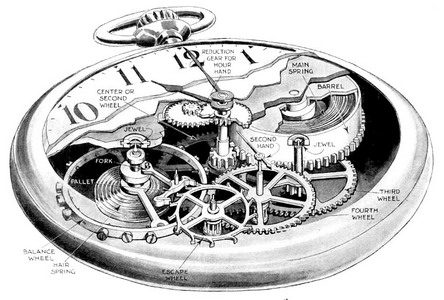
A cutaway diagram of a pocket watch showing the essential parts of a watch.
After watching a few "Wristwatch Revival" vids I started watching other watchmaking vids and I was amazed at just how many there are and how successful they can be. Two of the most authoritative and interesting would have to be Watch Repair Channel and Chronoglide Watchmakers. Before I long I was able name the major parts in a wristwatch and understood how it all works. They are pretty simple really with the exception of the balance wheel and escapement. Essentially it's just a spring driving a train of wheels that turns the hands. The tricky bit is the beating heart of a watch: the balance wheel - escapement partnership. Pretty much all wristwatches to the present day utilise the Swiss lever escapement to achieve this.
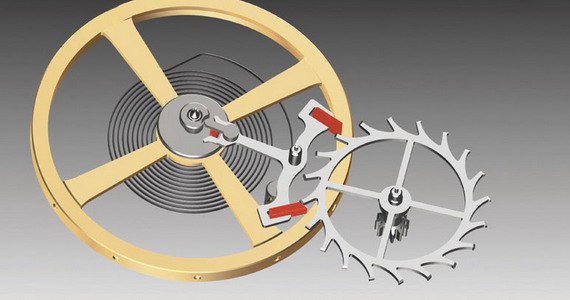
The Swiss lever escapement.
In order to prevent the mainspring unwinding in a few seconds and the hands flying around like helicopter blades the motion must be greatly slowed down and this is done by the escapement wheel that drip feeds power to the hands one tick at a time. But how is THAT controlled? The answer is that it is done by a harmonic oscillator that tells the escapement wheel when to release another tooth. In theory the period of a harmonic oscillator is independent of its amplitude which means that it can be an accurate keeper of time. This is true whether it is based on a pendulum, like a wall clock, or a spring and wheel, like a wristwatch. This is great but how do you connect the escapement to the balance wheel so that it all works? This is the tricky part and this is where the genius comes in.
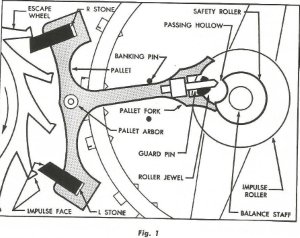
the essential parts of pallet fork and balance wheel
If you check the Wikipedia page for the Swiss lever escapement, or almost any other page on the internet, (and there are MANY), you will NOT find out the secret of how it works! The Wikipedia page will tell you that the impulse pin knocks the lever fork which releases the escapement which moves forward one tooth which knocks the lever across to the opposite banking pin which knocks the impulse pin which provides the balance wheel with the power it needs to keep rotating. This is all true BUT there are TWO separate functions of the impulse pin yet there appears to be only ONE connection to it. How can it work? ![]()
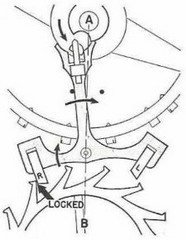
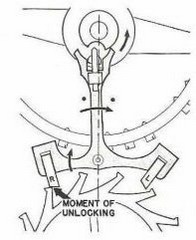
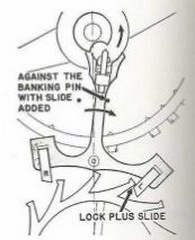
The 3 critical stages of the impulse pin.
What 99% of the pages on the subject neglect to mention is the FORK SLOT! It's not even named on the above parts diagram but without it you don't have an escapement. Essentially the slot has two faces and is just slightly wider that the impulse pin, (aka the impulse jewel, aka the roller jewel). As you can see from the above diagram, when the balance wheel swings back the lever fork is open which allows the impulse jewel to just enter the fork slot and strike the leading face of that slot. This moves the fork into the centre and unlocks the escapement wheel via the pallet jewel which allows that wheel to move forward one tooth and advance the second hand. The face of the pallet jewel is cut at a precise angle so that as the escapement wheel tooth moves across it it imparts a little kick which swings the fork further across until it strikes the opposite banking pin where it stops and prevents the escapement wheel from turning any further. As the lever fork swings across the trailing edge of the fork slot strikes the impulse pin imparting the necessary energy to keep the balance wheel swinging with good amplitude. The impulse pin is able to leave the fork slot because the motion of the lever fork has opened its mouth on the exit side.
To further complicate the understanding of this mechanism you can see a guard pin, a safety roller and a passing hollow. These are there simply to prevent the lever from swinging across and unlocking the escapement at the wrong time. For example if the watch were knocked or just shaken this would often be enough to cause the watch to jump a second. I imagine that over time the accumulated error of frequent second jumping would become unacceptable, so the "safety" mechanism was invented. Essentially the guard pin prevents the lever from swinging across unless the passing hollow is directly inline with it, ie when the lever is supposed to swing across. Note that the mechanism is 3 dimensional and the guard pin is NOT in the same plane as the fork slot and impulse pin.
And that's the full story of how the heart of a watch works. Thanks to Mark Sirianni for his page on the subject that showed what all the others did not! Yes! It is a complex mechanism BUT it works and works well! ![]()
Having acquired a basic understanding of watchmaking theory and practise I thought: "How hard can it be? Can I do this?" and thus my watchmaking journey began. I ordered the necessary tools from eBay and AliExpress and some parts and a practice pocket watch and away I went. Proper Swiss made watchmaking tools from manufacturers like Bergeon are VERY expensive and I could not justify such costs so I simply sourced the best cheap stuff I could. The experts say that you should only buy the best screwdrivers for example but they are ridiculously expensive for a full set and you can't really get by with just 3. Watchmaking tools are a rather arcane business and there are far too many highly specialised tools available and the beginner is faced with the difficult problem of what to leave out. You probably don't need a staking tool to start with however a mainspring winder may be essential but the cheap ones don't fit every movement and aren't really cheap anyway. Then there are tools like the canon pinion puller which are almost unobtainable... What do you do? ![]()
Chiefest among the tools every watchmaker needs is a magnifying device! The experts all use a long working distance stereo microscope, often with a video output. You can get these online for a reasonable price but it's still too much for a beginner who is just trying the water. I tried a jeweller's 10x loupe but they are just hopeless as the working distance is something 1 or 2 inches. It may be just possible but it is extremely uncomfortable and for me at least not practical. I settled on a long working distance illuminated magnifier. This was fairly impressive but did not produce the advertised 10x magnification at a typical working distance. Nonetheless it DID work and I was able to get stuck in!
I disassembled my Chinese pocket watch for a start and the first thing I discovered was that those tiny screws are a REAL PAIN to deal with! When you watch experienced watchmakers online dropping screws into their holes and doing them up it looks easy. Believe me: It isn't! It's something you get better at with experience I guess... Another thing that everyone mentions is that those tiny parts go flying at the slightest opportunity and when they land on your carpet they are VERY difficult to find! Never was there a truer word spoken! ![]()
BTW it is ABSURD how expensive watchmaking oil is! $60 for 5ml!!! It hurt to pay such a stupid price but everyone says there is no real alternative and there isn't a clear alternative anyway. Seiko use their own but I was unable to source that. You can buy some Chinese oil for cheap but it has no specs on it so you don't know what you're getting. One or two people online claim to have used 20W50 engine oil with good results and I imagine that sewing machine oil might be satisfactory but I wasn't willing to risk it. You also need more than one type of oil depending on the part you are lubricating so I bit the bullet and bought the best...

Ali Express dispute completion. (click for full res)
I got bored with my pocket watch while I was waiting for some Moebius oil to arrive so I decided to build my own watch from parts sourced from AliExpress. I DON'T RECOMMEND AliExpress as the management don't really care about foreign customers and seem happy to tolerate their merchants attempting to defraud such customers. This doesn't mean that all AliExpress merchants are thieves, far from it, but in my experience about 10% of their merchants ARE thieves. Their common trick is to tell you that they have sent an item when they haven't, tell you that it has been delivered when it hasn't, admit that they never sent it, then tell you that they will give you an immediate refund if you will just mark the item as received. Naturally if you do this the merchant will refuse to refund your money and you will have no comeback. In the West we call this STEALING! ![]()
If you complain to AliExpress you may be able to open a dispute with the merchant, (although merchants have ways to make this difficult), which will likely result in you obtaining a refund BUT you will be waiting at least 70 DAYS! AliExpress do have customer support and you can complain about a merchant and ask them to investigate. Your customer service rep will assure you that they do not tolerate such behaviour and that they will forward it to their higher team and that action will certainly be taken within a week and the merchant will be punished and you will get your refund. That is what they will say but they will actually do NOTHING! In my case Fashionable jewellery&accessories Store attempted to defraud me over a PT5000 movement that I purchased for $76AU. They even went so far as to lodge a fraudulent delivery slip from AliExpress' own agent! I complained 3 times to AliExpress over a period of weeks and spoke to 3 different people. Each one assured me that action would be taken and that I would receive a swift refund yet nothing was done. It is clear to me that they regard foreigners as free game. To be fair I DID eventually get my refund but it took 75 days. Yes there are bargains to be had with AliExpress but remember that 10% of your orders will not arrive and you will have to fight to get a refund. eBay may be more expensive but you have much better comeback. Caveat emptor!![]()
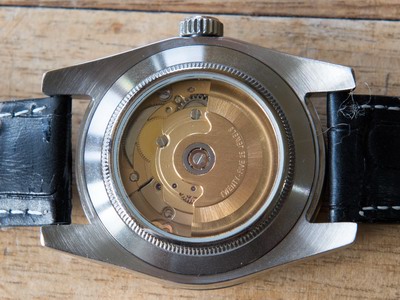
My watch back, showing the movement. Is it a real PT5000? No way to be sure.
At length I had all the necessary tools and parts and I was able to commence work on making my own watch. I chose a PT5000 movement which is, (in theory), a world class clone of the famous Swiss ETA 2824 high beat movement. Hong Kong Precision Technology were able to get a chronometer certification for this movement and people online reported accuracies of better than 1 second per day, which is truly up there with the best! It seemed a great bargain if I could source a copy that would deliver such results but how can you even know whether you have a real PT5000? Certainly you can't believe AliExpress merchants and Hong Kong Precision Technology don't even label their movement, or at least they didn't at the time I ordered so you have no way to be certain of what you have. You can see however, under high magnification that the unit is well made. The gears are beautifully cut for example and when you compare it to the cheaper clones you can see the difference in quality.
I wanted my first watch to be of high quality so I ordered a waterproof polished stainless steel case that wasn't too large, with a screw-down crown and a sapphire crystal. I wanted an Arabic numeral dial and found this surprisingly hard to source. The Chinese seem to have no imagination, no individuality and all just make the same thing that sells, usually a copy of Rolex. Whoops! an "homage" not a copy... I wanted white and silver numbers on a black dial and white and silver hands as that would make the most readable face. Since the 2824 has a calendar ring I wanted a date window and I chose a cyclops case to make that more readable as I would otherwise need specs to read the date. All right! I had the bits and I was ready to go! ![]()
The first problem I found was that movement spacer and the case clamps did NOT fit! Now this shouldn't happen as they come with the case and the case manufacturer knows precisely how large their case is and how large the target movement is. They really have no excuse for sending you the wrong size mounting parts. Sadly this is the story for most things bought from China. The merchants SIMPLY DON'T CARE about quality or customer satisfaction. Once they have your money you can go fuck yourself as far they are concerned. So I had to order a set of variable sized mounting clamps, one of which would surely do the job! The spacer was a different matter however so I had to cut down the one they sent me, using a Stanley knife to pare away the plastic until it fitted correctly. ![]()
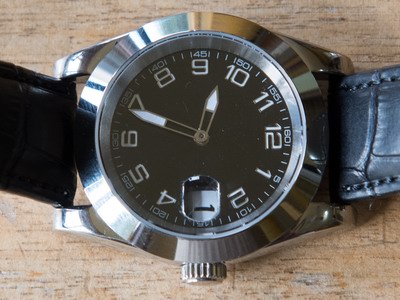
My watch face, note the missing second hand.
My second problem made itself apparent when I went to fit the hands. They simply wouldn't go on! Eventually I got them on but they were a VERY tight fit and I had to use more force than I thought wise. Certainly nothing like the simple job it looked like on the YouTube clips. Did they send me hands that were the wrong size? I can't be certain but it took me many goes to get them roughly right. Sadly, after I had the watch fully assembled I found that I had forgotten to align the date change with midnight so I had to uncase the movement once more and redo the hands. They refused to behave and in attempting to place the recalcitrant seconds hand I found I had bent it badly. I straightened it but the very thin metal fatigued and broke. Thus it was that I lost my seconds hand. Ah well, I can replace it one day... ![]()
The third problem I discovered was that at some point I had forgotten to always pull the winding stem all the way out before removing it each time I had to take the movement out of the case. This meant that at some point the sliding clutch had slid over its engagement fork and the watch therefore refused to wind. The automatic winding works still functioned though so I could still wear it and use it but it wasn't fully functional. This problem is fixable but for the moment I didn't want to go any further until I had worn it for some time.
So it was certainly NOT the simple job it appeared to be on YouTube! Nevertheless I had persisted and had achieved my goal! The watch lacked a second hand, the hand winder didn't work but it looked good and worked ok and I was reasonably happy with my first effort. Sadly it didn't keep great time gaining about 30 seconds a day which might be just within spec but I was hoping for much better. I could try adjusting it but that along with the other matter must wait for another day.
![]()
It has been quite a journey even though this is just the first milestone. I have lost interest in watchmaking for the time being although I may well resume it in the future. I respect those who are good at it and enjoy it but I would advise anyone who thinks you can just jump in and have the success the YouTubers have to read this story first. Good luck to anyone that wants to jump in. There is quite a learning curve and a cost barrier though. I think that a good long working distance stereo microscope is pretty much essential...
Finally, I read that a "constant force escapement" is the holy grail of watchmaking so I set about designing one. I looked at the Girard-Perregaux solution but I wondered why it was that despite all the ballyhoo it is not really available... Perhaps it doesn't keep good enough time? I don't know but I wonder. Anyway I found a much simpler solution that doesn't require much redesign. Maybe someday I will submit it to a major horological house. I'd patent it but the international patent system is huge money pit that acts to STOP small inventors from protecting their work. It's yet another example of the evil legal system across the world that is only there to protect the RICH.
Currently watching:
The Beatles: Get Back directed by Peter Jackson.